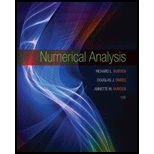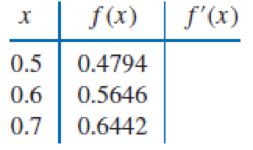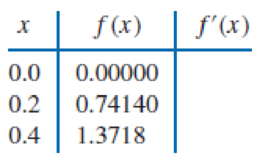
Numerical Analysis
10th Edition
ISBN: 9781305253667
Author: Richard L. Burden, J. Douglas Faires, Annette M. Burden
Publisher: Cengage Learning
expand_more
expand_more
format_list_bulleted
Concept explainers
Textbook Question
Chapter 4.1, Problem 3ES
The data in Exercise 1 were taken from the following functions. Compute the actual errors in Exercise 1, and find error bounds using the error formulas.
- a. f (x) = sin x
- b. f (x) = ex − 2x2 + 3x − 1
1. Use the forward-difference formulas and backward-difference formulas to determine each missing entry in the following tables.


Expert Solution & Answer
Trending nowThis is a popular solution!

Students have asked these similar questions
When a tennis player serves, he gets two chances to serve in bounds. If he fails to do so twice, he loses the point. If he
attempts to serve an ace, he serves in bounds with probability 3/8.If he serves a lob, he serves in bounds with probability
7/8. If he serves an ace in bounds, he wins the point with probability 2/3. With an in-bounds lob, he wins the point with
probability 1/3. If the cost is '+1' for each point lost and '-1' for each point won, the problem is to determine the optimal
serving strategy to minimize the (long-run)expected average cost per point. (Hint: Let state 0 denote point over,two
serves to go on next point; and let state 1 denote one serve left.
(1). Formulate this problem as a Markov decision process by identifying the states and decisions and then finding the
Cik.
(2). Draw the corresponding state action diagram.
(3). List all possible (stationary deterministic) policies.
(4). For each policy, find the transition matrix and write an expression for the…
During each time period, a potential customer arrives at a restaurant with probability 1/2. If there are already two people
at the restaurant (including the one being served), the potential customer leaves the restaurant immediately and never
returns. However, if there is one person or less, he enters the restaurant and becomes an actual customer. The manager
has two types of service configurations available. At the beginning of each period, a decision must be made on which
configuration to use. If she uses her "slow" configuration at a cost of $3 and any customers are present during the period,
one customer will be served and leave with probability 3/5. If she uses her "fast" configuration at a cost of $9 and any
customers are present during the period, one customer will be served and leave with probability 4/5. The probability of
more than one customer arriving or more than one customer being served in a period is zero. A profit of $50 is earned
when a customer is served. The manager…
Every Saturday night a man plays poker at his home with the same group of friends. If he provides refreshments for the
group (at an expected cost of $14) on any given Saturday night, the group will begin the following Saturday night in a
good mood with probability 7/8 and in a bad mood with probability 1/8. However, if he fail to provide refreshments, the
group will begin the following Saturday night in a good mood with probability 1/8 and in a bad mood with probability
7/8 regardless of their mood this Saturday. Furthermore, if the group begins the night in a bad mood and then he fails
to provide refreshments, the group will gang up on him so that he incurs expected poker losses of $75. Under other
circumstances he averages no gain or loss on his poker play. The man wishes to find the policy regarding when to
provide refreshments that will minimize his (long-run) expected average cost per week.
(1). Formulate this problem as a Markov decision process by identifying the states and…
Chapter 4 Solutions
Numerical Analysis
Ch. 4.1 - Use the forward-difference formulas and...Ch. 4.1 - The data in Exercise 1 were taken from the...Ch. 4.1 - Use the most accurate three-point formula to...Ch. 4.1 - Use the most accurate three-point formula to...Ch. 4.1 - The data in Exercise 5 were taken from the...Ch. 4.1 - The data in Exercise 6 were taken from the...Ch. 4.1 - Prob. 9ESCh. 4.1 - Use the formulas given in this section to...Ch. 4.1 - The data in Exercise 9 were taken from the...Ch. 4.1 - Prob. 12ES
Ch. 4.1 - Use the following data and the knowledge that the...Ch. 4.1 - Prob. 14ESCh. 4.1 - Prob. 15ESCh. 4.1 - Prob. 16ESCh. 4.1 - Prob. 17ESCh. 4.1 - Prob. 18ESCh. 4.1 - Prob. 19ESCh. 4.1 - Prob. 20ESCh. 4.1 - Prob. 21ESCh. 4.1 - In a circuit with impressed voltage (t) and...Ch. 4.1 - In Exercise 9 of Section 3.4, data were given...Ch. 4.1 - Derive an O(h4) five-point formula to approximate...Ch. 4.1 - Use the formula derived in Exercise 24 and the...Ch. 4.1 - a. Analyze the round-off errors, as in Example 4,...Ch. 4.1 - Derive a method for approximating f (x0) whose...Ch. 4.1 - Consider the function e(h)=h+h26M, where M is a...Ch. 4.1 - Prob. 1DQCh. 4.1 - Prob. 2DQCh. 4.2 - Apply the extrapolation process described in...Ch. 4.2 - Add another line to the extrapolation table in...Ch. 4.2 - The following data give approximations to the...Ch. 4.2 - Prob. 6ESCh. 4.2 - Prob. 7ESCh. 4.2 - The forward-difference formula can be expressed as...Ch. 4.2 - Prob. 9ESCh. 4.2 - Prob. 10ESCh. 4.2 - Prob. 11ESCh. 4.2 - Prob. 12ESCh. 4.2 - Prob. 13ESCh. 4.3 - Approximate the following integrals using the...Ch. 4.3 - Approximate the following integrals using the...Ch. 4.3 - Find a bound for the error in Exercise 1 using the...Ch. 4.3 - Prob. 4ESCh. 4.3 - Repeat Exercise 1 using Simpsons rule. 1....Ch. 4.3 - Prob. 6ESCh. 4.3 - Prob. 7ESCh. 4.3 - Prob. 8ESCh. 4.3 - Prob. 9ESCh. 4.3 - Prob. 10ESCh. 4.3 - Prob. 11ESCh. 4.3 - Prob. 12ESCh. 4.3 - The Trapezoidal rule applied to 02f(x)dx gives the...Ch. 4.3 - Prob. 14ESCh. 4.3 - Approximate the following integrals using formulas...Ch. 4.3 - Prob. 17ESCh. 4.3 - Suppose that the data of Exercise 17 have...Ch. 4.3 - Prob. 19ESCh. 4.3 - Prob. 20ESCh. 4.3 - The quadrature formula...Ch. 4.3 - The quadrature formula...Ch. 4.3 - Find the constants c0, c1, and x1 so that the...Ch. 4.3 - Find the constants x0, x1, and c1 so that the...Ch. 4.3 - Prob. 25ESCh. 4.3 - Prob. 26ESCh. 4.3 - Prob. 27ESCh. 4.3 - Derive Simpsons Three-Eighths rule (the closed...Ch. 4.3 - Prob. 1DQCh. 4.3 - Prob. 2DQCh. 4.4 - Use the Composite Trapezoidal rule with the...Ch. 4.4 - Prob. 2ESCh. 4.4 - Use the Composite Simpsons rule to approximate the...Ch. 4.4 - Prob. 4ESCh. 4.4 - Prob. 5ESCh. 4.4 - Prob. 6ESCh. 4.4 - Prob. 7ESCh. 4.4 - Prob. 8ESCh. 4.4 - Prob. 9ESCh. 4.4 - Prob. 10ESCh. 4.4 - Determine the values of n and h required to...Ch. 4.4 - Repeat Exercise 11 for the integral 0x2cosxdx. 11....Ch. 4.4 - Determine the values of n and h required to...Ch. 4.4 - Repeat Exercise 13 for the integral 12xlnxdx. 13....Ch. 4.4 - Prob. 15ESCh. 4.4 - Prob. 17ESCh. 4.4 - A car laps a race track in 84 seconds. The speed...Ch. 4.4 - Prob. 19ESCh. 4.4 - Prob. 20ESCh. 4.4 - Prob. 21ESCh. 4.4 - Prob. 23ESCh. 4.4 - Prob. 24ESCh. 4.4 - Prob. 25ESCh. 4.4 - Prob. 26ESCh. 4.4 - Prob. 1DQCh. 4.4 - Prob. 2DQCh. 4.5 - Use Romberg integration to compute R3, 3 for the...Ch. 4.5 - Use Romberg integration to compute R3, 3 for the...Ch. 4.5 - Prob. 3ESCh. 4.5 - Prob. 4ESCh. 4.5 - Use the following data to approximate 15f(x)dx as...Ch. 4.5 - Prob. 9ESCh. 4.5 - Prob. 10ESCh. 4.5 - Prob. 11ESCh. 4.5 - Romberg integration for approximating 01f(x)dx...Ch. 4.5 - Prob. 15ESCh. 4.5 - Prob. 18ESCh. 4.5 - Prob. 19ESCh. 4.5 - Prob. 1DQCh. 4.5 - Prob. 4DQCh. 4.6 - Prob. 1ESCh. 4.6 - Prob. 2ESCh. 4.6 - Prob. 11ESCh. 4.6 - Prob. 12ESCh. 4.6 - Could Romberg integration replace Simpsons rule in...Ch. 4.7 - Approximate the following integrals using Gaussian...Ch. 4.7 - Approximate the following integrals using Gaussian...Ch. 4.7 - Repeat Exercise 1 with n = 3. 1. Approximate the...Ch. 4.7 - Repeat Exercise 2 with n = 3. 2. Approximate the...Ch. 4.7 - Repeat Exercise 1 with n = 4. 1. Approximate the...Ch. 4.7 - Repeat Exercise 2 with n = 4. 2. Approximate the...Ch. 4.7 - Repeat Exercise 1 with n = 5. 1. Approximate the...Ch. 4.7 - Repeat Exercise 2 with n = 5. 2. Approximate the...Ch. 4.7 - Describe the differences and similarities between...Ch. 4.7 - Prob. 2DQCh. 4.8 - Prob. 1DQCh. 4.8 - Prob. 2DQCh. 4.8 - Prob. 3DQCh. 4.8 - Prob. 4DQCh. 4.9 - Suppose a body of mass m is traveling vertically...Ch. 4.9 - The Laguerre polynomials {L0(x), L1(x) ...} form...Ch. 4.9 - Prob. 7ESCh. 4.9 - Prob. 8ESCh. 4.9 - Prob. 9ESCh. 4.9 - Prob. 1DQCh. 4.9 - Prob. 2DQ
Additional Math Textbook Solutions
Find more solutions based on key concepts
1. How much money is Joe earning when he’s 30?
Pathways To Math Literacy (looseleaf)
Is there a relationship between wine consumption and deaths from heart disease? The table gives data from 19 de...
College Algebra Essentials (5th Edition)
23. A plant nursery sells two sizes of oak trees to landscapers. Large trees cost the nursery $120 from the gro...
College Algebra (Collegiate Math)
Provide an example of a qualitative variable and an example of a quantitative variable.
Elementary Statistics ( 3rd International Edition ) Isbn:9781260092561
NOTE: Write your answers using interval notation when appropriate.
CHECKING ANALYTIC SKILLS Fill in each blank ...
Graphical Approach To College Algebra
153. A rain gutter is made from sheets of aluminum that are 20 inches wide. As shown in the figure, the edges ...
College Algebra (7th Edition)
Knowledge Booster
Learn more about
Need a deep-dive on the concept behind this application? Look no further. Learn more about this topic, subject and related others by exploring similar questions and additional content below.Similar questions
- This year Amanda decides to invest in two different no-load mutual funds: the G Fund or the L Mutual Fund. At the end of each year, she liquidates her holdings, takes her profits, and then reinvests. The yearly profits of the mutual funds depend on where the market stood at the end of the preceding year. Recently the market has been oscillating around level 2 from one year end to the next, according to the probabilities given in the following transition matrix : L1 L2 L3 L1 0.2 0.4 0.4 L2 0.1 0.4 0.5 L3 0.3 0.3 0.4 Each year that the market moves up (down) 1 level, the G Fund has profits (losses) of $20k, while the L Fund has profits (losses) of $10k. If the market moves up (down) 2 level in a year, the G Fund has profits (losses) of $50k, while the L Fund has profits (losses) of only $20k. If the market does not change, there is no profit or loss for either fund. Amanda wishes to determine her optimal investment policy in order to maximize her (long-run) expected average profit per…arrow_forwardEvaluate F. dr where F(x, y, z) = (2yz cos(xyz), 2xzcos(xyz), 2xy cos(xyz)) and C is the line π 1 1 segment starting at the point (8, ' and ending at the point (3, 2 3'6arrow_forwardSolve this questions pleasearrow_forward
- Find all positive integers n such that n.2n +1 is a square.arrow_forwardA researcher wishes to estimate, with 90% confidence, the population proportion of adults who support labeling legislation for genetically modified organisms (GMOs). Her estimate must be accurate within 4% of the true proportion. (a) No preliminary estimate is available. Find the minimum sample size needed. (b) Find the minimum sample size needed, using a prior study that found that 65% of the respondents said they support labeling legislation for GMOs. (c) Compare the results from parts (a) and (b). ... (a) What is the minimum sample size needed assuming that no prior information is available? n = (Round up to the nearest whole number as needed.)arrow_forwardThe table available below shows the costs per mile (in cents) for a sample of automobiles. At a = 0.05, can you conclude that at least one mean cost per mile is different from the others? Click on the icon to view the data table. Let Hss, HMS, HLS, Hsuv and Hмy represent the mean costs per mile for small sedans, medium sedans, large sedans, SUV 4WDs, and minivans respectively. What are the hypotheses for this test? OA. Ho: Not all the means are equal. Ha Hss HMS HLS HSUV HMV B. Ho Hss HMS HLS HSUV = μMV Ha: Hss *HMS *HLS*HSUV * HMV C. Ho Hss HMS HLS HSUV =μMV = = H: Not all the means are equal. D. Ho Hss HMS HLS HSUV HMV Ha Hss HMS HLS =HSUV = HMVarrow_forward
- Question: A company launches two different marketing campaigns to promote the same product in two different regions. After one month, the company collects the sales data (in units sold) from both regions to compare the effectiveness of the campaigns. The company wants to determine whether there is a significant difference in the mean sales between the two regions. Perform a two sample T-test You can provide your answer by inserting a text box and the answer must include: Null hypothesis, Alternative hypothesis, Show answer (output table/summary table), and Conclusion based on the P value. (2 points = 0.5 x 4 Answers) Each of these is worth 0.5 points. However, showing the calculation is must. If calculation is missing, the whole answer won't get any credit.arrow_forwardBinomial Prob. Question: A new teaching method claims to improve student engagement. A survey reveals that 60% of students find this method engaging. If 15 students are randomly selected, what is the probability that: a) Exactly 9 students find the method engaging?b) At least 7 students find the method engaging? (2 points = 1 x 2 answers) Provide answers in the yellow cellsarrow_forwardIn a survey of 2273 adults, 739 say they believe in UFOS. Construct a 95% confidence interval for the population proportion of adults who believe in UFOs. A 95% confidence interval for the population proportion is ( ☐, ☐ ). (Round to three decimal places as needed.)arrow_forward
- Find the minimum sample size n needed to estimate μ for the given values of c, σ, and E. C=0.98, σ 6.7, and E = 2 Assume that a preliminary sample has at least 30 members. n = (Round up to the nearest whole number.)arrow_forwardIn a survey of 2193 adults in a recent year, 1233 say they have made a New Year's resolution. Construct 90% and 95% confidence intervals for the population proportion. Interpret the results and compare the widths of the confidence intervals. The 90% confidence interval for the population proportion p is (Round to three decimal places as needed.) J.D) .arrow_forwardLet p be the population proportion for the following condition. Find the point estimates for p and q. In a survey of 1143 adults from country A, 317 said that they were not confident that the food they eat in country A is safe. The point estimate for p, p, is (Round to three decimal places as needed.) ...arrow_forward
arrow_back_ios
SEE MORE QUESTIONS
arrow_forward_ios
Recommended textbooks for you
 Algebra: Structure And Method, Book 1AlgebraISBN:9780395977224Author:Richard G. Brown, Mary P. Dolciani, Robert H. Sorgenfrey, William L. ColePublisher:McDougal LittellAlgebra & Trigonometry with Analytic GeometryAlgebraISBN:9781133382119Author:SwokowskiPublisher:Cengage
Algebra: Structure And Method, Book 1AlgebraISBN:9780395977224Author:Richard G. Brown, Mary P. Dolciani, Robert H. Sorgenfrey, William L. ColePublisher:McDougal LittellAlgebra & Trigonometry with Analytic GeometryAlgebraISBN:9781133382119Author:SwokowskiPublisher:Cengage
 Glencoe Algebra 1, Student Edition, 9780079039897...AlgebraISBN:9780079039897Author:CarterPublisher:McGraw Hill
Glencoe Algebra 1, Student Edition, 9780079039897...AlgebraISBN:9780079039897Author:CarterPublisher:McGraw Hill Holt Mcdougal Larson Pre-algebra: Student Edition...AlgebraISBN:9780547587776Author:HOLT MCDOUGALPublisher:HOLT MCDOUGAL
Holt Mcdougal Larson Pre-algebra: Student Edition...AlgebraISBN:9780547587776Author:HOLT MCDOUGALPublisher:HOLT MCDOUGAL College AlgebraAlgebraISBN:9781305115545Author:James Stewart, Lothar Redlin, Saleem WatsonPublisher:Cengage Learning
College AlgebraAlgebraISBN:9781305115545Author:James Stewart, Lothar Redlin, Saleem WatsonPublisher:Cengage Learning

Algebra: Structure And Method, Book 1
Algebra
ISBN:9780395977224
Author:Richard G. Brown, Mary P. Dolciani, Robert H. Sorgenfrey, William L. Cole
Publisher:McDougal Littell

Algebra & Trigonometry with Analytic Geometry
Algebra
ISBN:9781133382119
Author:Swokowski
Publisher:Cengage


Glencoe Algebra 1, Student Edition, 9780079039897...
Algebra
ISBN:9780079039897
Author:Carter
Publisher:McGraw Hill

Holt Mcdougal Larson Pre-algebra: Student Edition...
Algebra
ISBN:9780547587776
Author:HOLT MCDOUGAL
Publisher:HOLT MCDOUGAL

College Algebra
Algebra
ISBN:9781305115545
Author:James Stewart, Lothar Redlin, Saleem Watson
Publisher:Cengage Learning
Finding Local Maxima and Minima by Differentiation; Author: Professor Dave Explains;https://www.youtube.com/watch?v=pvLj1s7SOtk;License: Standard YouTube License, CC-BY